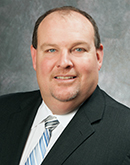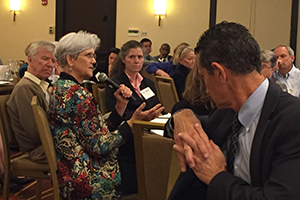By KIM VAN OOSTEN ALEXANDRIA, Va. — CHA's 2015 Global Summit here focused on the United Nation's newly-adopted 2030 Agenda for Sustainable Development and its intersection with the anti-poverty initiatives and international outreach programs of faith-based organizations.
The summit, Oct. 22-23, brought together more than 70 leaders and sponsors of Catholic health ministries and government, foundations and other non-governmental organizations to collectively consider opportunities for collaboration and challenges in conducting international work.

Compton
The U.N. General Assembly adopted its sustainable development agenda on Sept. 25, just minutes after Pope Francis addressed the body. The document contains 17 goals and a framework to fight extreme poverty and enhance medical and educational access over the next 15 years.
The first goal is to "End poverty in all its forms everywhere."
Archbishop Bernardito C. Auza, the Holy See's permanent observer to the United Nations and the Organization of American States, led the Holy See's delegation in the negotiations leading up to the adoption of the U.N. development agenda. He explained the process as well as the perspectives and priorities of the church to the Global Summit audience.
"We wanted to see a very strong language on the centrality of the human person," said Archbishop Auza. "We have to look beyond the numbers. We have to say that poverty is not only numbers … it is a complex of other forms of poverties … education, health, cultural poverty."
The archbishop noted disappointment that a paragraph on the importance of the family was struck from the document during the last two days of negotiations on its content. "The family is the primary driver of development," said the archbishop. "The family, where we learn social interpersonal values, even though now not included, should be considered in all of our efforts as a driver of the things we want to achieve."
Dr. Ariel Pablos-Mendez, assistant administrator for Global Health at the U.S. Agency for International Development told summit attendees that the expertise of CHA's members in running hospitals, governance, innovation and supply chain management are valued and greatly needed.

Sr. Patricia Eck, congregational leader of the Sisters of Bon Secours of Paris, makes a comment at CHA’s 2015 Global Summit. Seated with her are Dr. Donald G. Seitz, a board member of Bon Secours Health System, and Sr. Yudith Pereira-Rico, RJM, associate executive director of Solidarity with South Sudan.
Bruce Compton, CHA's senior director of international outreach said, "Our goal is to be a resource to our members as they continue to provide compassionate care at home and around the world. Part of our role, certainly, is to consider how we could help facilitate funding of this important global work." CHA's annual Global Summit "provides opportunities for agencies such as the U.N., the World Health Organization, USAID, universities and foundations to see our collective strength and the potential for ministry partnerships."
Rev. Adam Russell Taylor leads the Faith-Based Initiative of the World Bank Group. He said the development bank is making progress toward measuring the degree to which its investments are helping to combat inequality and to boost "share in prosperity."
In early October, the International Comparison Program, an independent consortium that sets a widely accepted global poverty rate based in part on purchasing power of the poor in the developing world, raised the threshold for extreme poverty to $1.90 a day. Rev. Taylor said it is a measure of the success of anti-poverty initiatives and "truly remarkable" that for the first time in history, less than 10 percent of the world's population lives in extreme poverty. It is a "testament to the work of so many of you in the room, as well as to so many other partners and organizations around the world," Rev. Taylor said.
Rev. Taylor capped his address with an Ethiopian proverb about the power of combined effort. "When spiders unite, they can entangle a lion," he said. "I love this image of a spider web because each and every strand of the web is very weak. And extreme poverty is like a lion that is devouring the dreams and denying the dignity to millions and millions of children, women and men around the world.
"But the spider web is all of you, it is the World Bank, it's USAID. We have to find ways to continue to form a much stronger web."
| CHA resources support mission outreach Three new CHA resources, the paired Short-Term Medical Mission Trips: Recommendations for Practice and Short-Term Medical Mission Trips Survey Results; and Guiding Principles for Conducting International Health Activities are available for order or for download on the CHA website. The publications are assessment and planning resources for those who approve, lead or participate in health promotion projects in the developing world, said Bruce Compton, CHA senior director of international outreach. The guiding principles
The guiding principles for conducting international health outreach were developed by a workgroup of ministry leaders experienced in mission programming who brought a deep understanding of Catholic social teaching and tradition to the work. The principles incorporate guidance from the World Health Organization and other groups. The principles include:
Prudence — Don't just do it Authenticity — Know thyself, know thy partner Honesty — Trust is earned and learned Patience — Build capacity, not dependency Excellence — Best intentions do not equal best practices Humility — We all have something to learn "While international activities are central to the mission of Catholic health care and are a formative experience for participants, there needs to be careful consideration to how they are conducted and how they are evaluated," Compton said. "We can't go into a community with a notion of what they want and need unless we have first undertaken assessments of needs and capacity. It's all about partnering," he said. The booklet elaborates on the six principles and includes reflection questions. Sr. Patricia A. Eck, CBS, congregation leader of the Sisters of Bon Secours of Paris, participated in the workgroup that helped develop the principles. She shared her experience and thoughts on the principles during a panel discussion at CHA's Global Health summit in October. "My hope is that this document with the principles will provide a framework for existing CEOs and new leaders who come into the ministry to understand why this work is important, and even more, that how we do this work is important," she said. To order or download the booklet, visit chausa.org/guidingprinciples. |
| Recommendations for medical mission trips Short-Term Medical Mission Trips: Recommendations for Practice, CHA's guide for conducting short term medical mission trips, incorporates learnings from two phases of research conducted on short-term medical mission trips — the first revealing the perspective and practices of the U.S.-based partners, and the second detailing the perspective and practices of those in the low- and middle-income countries who host medical missionaries. The research is detailed in a related publication, Short-Term Medical Mission Trips Survey Results. The recommendations for practice booklet includes 20 recommendations for evaluating a medical mission trip before committing to the endeavor, conducting a successful trip, and assessing the results. The question-by-question Phase I and Phase II results can be found in Short-Term Medical Mission Trips Survey Results. The surveys were done electronically and researchers conducted phone interviews to take a deeper dive into the topic. The first phase polling U.S.-based partners was conducted by two academics both with experience in public health and the outcomes of medical mission trips, and the second survey polling hosts of medical missions was conducted by Accenture Development Partners. The Phase II research was underwritten in part by Ascension Global Health Ministries. Bruce Compton, CHA's senior director of international outreach, outlined the Phase II research findings at the Global Summit. They include: Preparation and selection of volunteers — Volunteers should know about local culture and customs and be willing to teach — and learn from — members' local community. Length of trip — Phase II respondents said two weeks is the ideal length for a medical mission trip. Interviewees indicated that longer than two-week stays, without a true long-term commitment, are burdensome on hosts but weeklong trips are not impactful. Needs assessment — Organizations hosting medical missionaries said the host organization should conduct their own needs assessment (with support and guidance from the partner U.S. organization). Involvement — Host organizations want to direct volunteers and activities and define the goals of any short-term medical mission trip. Evaluation — Phase II respondents voiced the need to provide honest feedback to their U.S. partners. Capacity building — Host organizations said they would welcome more mentoring, training and education from medical missionaries. The recommendations for practice and research booklets are available for order or download at www.chausa.org/international. |
Copyright © 2014 by the Catholic Health Association
of the United States
For reprint permission, contact Betty Crosby
or call (314) 253-3477.